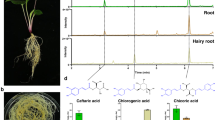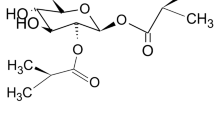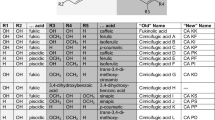Abstract
One of the most common types of modification of secondary metabolites is the acylation of oxygen- and nitrogen-containing substrates to produce esters and amides, respectively. Among the known acyltransferases, the members of the plant BAHD family are capable of acylating a wide variety of substrates. Two full-length acyltransferase cDNAs (LaAT1 and 2) were isolated from lavender flowers (Lavandula angustifolia L.) by reverse transcriptase-PCR using degenerate primers based on BAHD sequences. Recombinant LaAT1 exhibited a broad substrate tolerance accepting (hydroxy)cinnamoyl-CoAs as acyl donors and not only tyramine, tryptamine, phenylethylamine and anthranilic acid but also shikimic acid and 4-hydroxyphenyllactic acid as acceptors. Thus, LaLT1 forms esters and amides like its phylogenetic neighbors. In planta LaAT1 might be involved in the biosynthesis of rosmarinic acid, the ester of caffeic acid and 3,4-dihydroxyphenyllactic acid, a major constituent of lavender flowers. LaAT2 is one of three members of clade VI with unknown function.





Similar content being viewed by others
Abbreviations
- 4CL:
-
(Hydroxy)cinnamic acid:CoA ligase
- BAHD:
-
Family of acyltransferases named after the first four biochemically characterized enzymes
- DTT:
-
Dithiothreitol
- GC–MS:
-
Gas chromatography mass spectrometry
- GST:
-
Glutathion S-transferase
- HCAA:
-
Hydroxycinnamic acid amides
- HPLC-ESI-MSn :
-
High-performance liquid chromatography electrospray ionization mass spectrometry
- IPTG:
-
Isopropyl-β-d-thiogalactopyranoside
- RACE:
-
Rapid amplification of cDNA ends
- RT-PCR:
-
Reverse transcriptase polymerase chain reaction
- SDS-PAGE:
-
Sodium dodecylsulphate polyacrylamide gel electrophoresis
- THT:
-
Tyramine N-(hydroxycinnamoyl) transferase
References
Aharoni A, Keizer LC, Bouwmeester HJ, Sun Z, Alvarez-Huerta M, Verhoeven HA, Blaas J, van Houwelingen AM, De Vos RC, van der Voet H, Jansen RC, Guis M, Mol J, Davis RW, Schena M, van Tunen AJ, O’Connell AP (2000) Identification of the SAAT gene involved in strawberry flavor biogenesis by use of DNA microarrays. Plant Cell 12:647–662
Back K, Jang SM, Lee B-C, Schmidt A, Strack D, Kim K-M (2001) Cloning and characterization of a hydroxycinnamoyl-CoA:tyramine N-(hydroxycinnamoyl) transferase induced in response to UV-C and wounding from Capsicum annuum. Plant Cell Physiol 42:475–481
Barratt NM, Dong W, Gage DA, Magnus V, Town CD (1999) Metabolism of exogenous auxin by Arabidopsis thaliana: Identification of the conjugate N α-(indol-3-ylacetyl)-glutamine and initiation of a mutant screen. Physiol Plant 105:207–217
Berger A, Meinhard J, Petersen M (2006) Rosmarinic acid synthase is a new member oft the superfamily of BAHD acyltransferases. Planta 224:1503–1510
Beuerle T, Pichersky E (2002) Enzymatic synthesis and purification of aromatic coenzyme A esters. Anal Biochem 302:305–312
Bradford MM (1976) A rapid and sensitive method for the quantitation of microgram quantities of protein utilizing the principle of protein-dye binding. Anal Biochem 72:248–254
Burhenne K, Kristensen BK, Rasmussen SK (2003) A new class of N-hydroxycinnamoyltransferases. J Biol Chem 278:13919–13927
Cowan MM (1999) Plant products as antimicrobial agents. Clinic Microbiol Rev 12:564–582
Crombie L (1999) Natural product chemistry and its part in the defence against insects and fungi in agriculture. Pestic Sci 55:761–774
D’Auria JC (2006) Acyltransferases in plants: a good time to be BAHD. Curr Opin Plant Biol 9:331–340
D’Auria JC, Gershenzon J (2005) The secondary metabolism of Arabidopsis thaliana: growing like a weed. Curr Opin Plant Biol 8:308–316
Dixon RA (2001) Natural products and plant disease resistance. Nature 411:843–847
Dudareva N, Pichersky E, Gershenzon J (2004) Biochemistry of plant volatiles. Plant Physiol 135:1893–1902
Facchini PJ, Hagel J, Zulak KG (2002) Hydroxycinnamic acid amide metabolism; physiology and biochemistry. Can J Bot 80:577–589
Hoffmann L, Maury S, Martz F, Geoffroy P, Legrand M (2003) Purification, cloning, and properties of an acyltransferase controlling shikimate and quinate ester intermediates in phenylpropanoid metabolism. J Biol Chem 278:95–103
Hoffmann L, Besseau S, Geoffroy P, Ritzenthaler C, Meyer D, Lapierre C, Pollet B, Legrand M (2004) Silencing of hydroxycinnamoyl-coenzyme A shikimate/quinate hydroxycinnamoyltransferase affects phenylpropanoid biosynthesis. Plant Cell 16:1446–1465
Hohlfeld H, Schürmann W, Scheel D, Strack D (1995) Partial purification and characterization of hydroxycinnamoyl-coenzyme A:tyramine hydroxycinnamoyl-transferase from cell suspension cultures of Solanum tuberosum. Plant Physiol 107:545–552
Hohlfeld H, Scheel D, Strack D (1996) Purification of hydroxycinnamoyl-CoA:tyramine hydroxycinnamoyltransferase from cell-suspension cultures of Solanum tuberosum L. cv. Datura. Planta 199:166–168
Jang S-M, Ishihara A, Back K (2004) Production of coumaroylserotonin and feruloylserotonin in transgenic rice expression pepper hydroxycinnamoyl-coenzyme A:serotonin N-(hydroxycinnamoyl)transferase. Plant Physiol 135:346–356
Ma X, Koepke J, Panjikar S, Fritzsch G, Stöckigt J (2005) Crystal structure of vinorine synthase, the first representative of the BAHD superfamily. J Biol Chem 280:13576–13583
Meyers BC, Lee DK, Vu TH, Tej SS, Edberg SB, Matvienko M, Tindell LD (2004) Arabidopsis MPSS. An online resource for quantitative expression analysis. Plant Physiol 135:801–813
Milkowski C, Strack D (2004) Serine carboxypeptidase-like acyltransferases. Phytochemistry 65:517–524
Moglia A, Comino C, Lanteri S, de Vos R, de Waard P, van Beek TA, Goitre L, Retta SF, Beekwilder J (2010) Production of novel antioxidative phenolic amides through heterologous expression of the plant’s chlorogenic acid biosynthesis genes in yeast. Metabol Eng 12:223–232
Nakane E, Kawakita K, Doke N, Yoshioka H (2003) Elicitation of primary and secondary metabolism during defense in the potato. J Gen Plant Pathol 69:378–384
Nicholson RL, Wood KV (2001) Phytoalexins and secondary products, where are they and how can we measure them? Physiol Mol Plant Pathol 59:63–69
Niggeweg R, Michael AJ, Martin C (2004) Engineering plants with increased levels of the antioxidant chlorogenic acid. Nature Biotechnol 22:746–754
Petersen M (1991) Characterization of rosmarinic acid synthase from cell cultures of Coleus blumei. Phytochemistry 30:2877–2881
Petersen M (1997) Cyctochrome P450-dependent hydroxylation in the biosynthesis of rosmarinic acid in Coleus. Phytochemistry 45:1165–1172
Petersen M, Alfermann AW (1988) Two new enzymes of rosmarinic acid biosynthesis from cell cultures of Coleus blumei: hydroxyphenylpyruvate reductase and rosmarinic acid synthase. Z Naturforsch 43c:501–504
Petersen M, Metzger JW (1993) Identification of the reaction products of rosmarinic acid synthase from cell cultures of Coleus blumei by ion spray mass spectrometry and tandem mass spectrometry. Phytochem Anal 4:131–134
Petersen M, Simmonds MSJ (2003) Molecules of interest: rosmarinic acid. Phytochemistry 62:121–125
Petersen M, Häusler E, Karwatzki B, Meinhard J (2003) Proposed biosynthetic pathway for rosmarinic acid in cell cultures of Coleus blumei Benth. Planta 189:10–14
Petersen M, Abdullah Y, Benner J, Eberle D, Gehlen K, Hücherig S, Janiak V, Kim KH, Sander M, Weitzel C, Wolters S (2009) Evolution of rosmarinic acid biosynthesis. Phytochemistry 70:1663–1679
Schmidt A, Grimm R, Schmidt J, Scheel D, Strack D, Rosahl S (1999) Cloning and expression of a potato cDNA encoding hydroxycinnamoyl-CoA:tyramine N-(hydroxycinnamoyl)transferase. J Biol Chem 274:4273–4280
Schoch G, Goepfer S, Morant M, Hehn A, Meyer D, Ullmann P, Werck-Reichert D (2001) CYP98A3 from Arabidopsis thaliana is a 3′-hydroxylase of phenolic esters, a missing link in the phenylpropanoid pathway. J Biol Chem 276:36566–36574
Schwab W (2003) Metabolome diversity: too many metabolites too few genes. Phytochemistry 62:837–849
Shellie R, Mondello L, Marriot P, Dugo G (2002) Characterization of lavender essential oils by using gas chromatography-mass spectrometry with correlation of linear retention indices and comparison with comprehensive two-dimensional gas chromatography. J Chromatogr A 970:225–234
Tzafrir I, Dickerman A, Brazhnik O, Nguyen Q, McElver J, Frye C, Patton D, Meinke D (2003) The Arabidopsis seedgenes project. Nucleic Acids Res 31:90–93
von Roepenack-Lahaye E, Newmann M-A, Schornack S, Hammond-Kosack KE, Lahaye T, Jones JDG, Daniels MJ, Dow JM (2003) p-Coumaroylnoradrenaline, a novel plant metabolite implicated in tomato defense against pathogens. J Biol Chem 278:43373–43383
Walker K, Long R, Croteau R (2002) The final acylation step in taxol biosynthesis: cloning of the taxoid C13-side-chain N-benzoyltransferase from Taxus. Proc Natl Acad Sci USA 99:9166–9171
Wheeler DL, Church DM, Federhen S, Lash AE, Madden TL, Pontius JU, Schuler GD, Schrimi LM, Sequeira E, Tatusova TA, Wagner L (2003) Database resources of the National Center for Biotechnology. Nucleic Acids Res 31:28–33
Yang Q, Reinhard K, Schiltz E, Matern U (1997) Characterization and heterologous expression of hydroxycinnamoyl/benzoyl-CoA: anthranilate N-hydroxycinnamoyl/benzoyltransferase from elicited cell cultures of carnation, Dianthus caryophyllus L. Plant Mol Biol 35:777–789
Yang Q, Trinh HX, Imai S, Ishihara A, Zhang L, Nakayashiki H, Tosa Y, Mayama S (2004) Analysis of the involvement of hydroxyanthranilate hydroxycinnamoyl-transferase and caffeoyl-CoA 3-O-methyltransferase in phytoalexin biosynthesis in oat. Mol Plant Microbe Interact 17:81–89
Acknowledgments
We thank Till Beuerle (Institute for Pharmaceutical Biology, Technical University Braunschweig, Braunschweig, Germany) and Eran Pichersky (Department of Molecular, Cellular and Developmental Biology, University of Michigan, Ann Arbor, USA) for providing the (hydroxy)cinnamic acid:CoA ligase gene. The financial support by Degussa is gratefully acknowledged.
Author information
Authors and Affiliations
Corresponding author
Additional information
The nucleotide sequences reported in this article have been deposited in the GenBank database under Accession Nos. DQ886904 (LaAT1) and DQ886905 (LaAT2).
Electronic supplementary material
Rights and permissions
About this article
Cite this article
Landmann, C., Hücherig, S., Fink, B. et al. Substrate promiscuity of a rosmarinic acid synthase from lavender (Lavandula angustifolia L.). Planta 234, 305–320 (2011). https://doi.org/10.1007/s00425-011-1400-5
Received:
Accepted:
Published:
Issue Date:
DOI: https://doi.org/10.1007/s00425-011-1400-5




